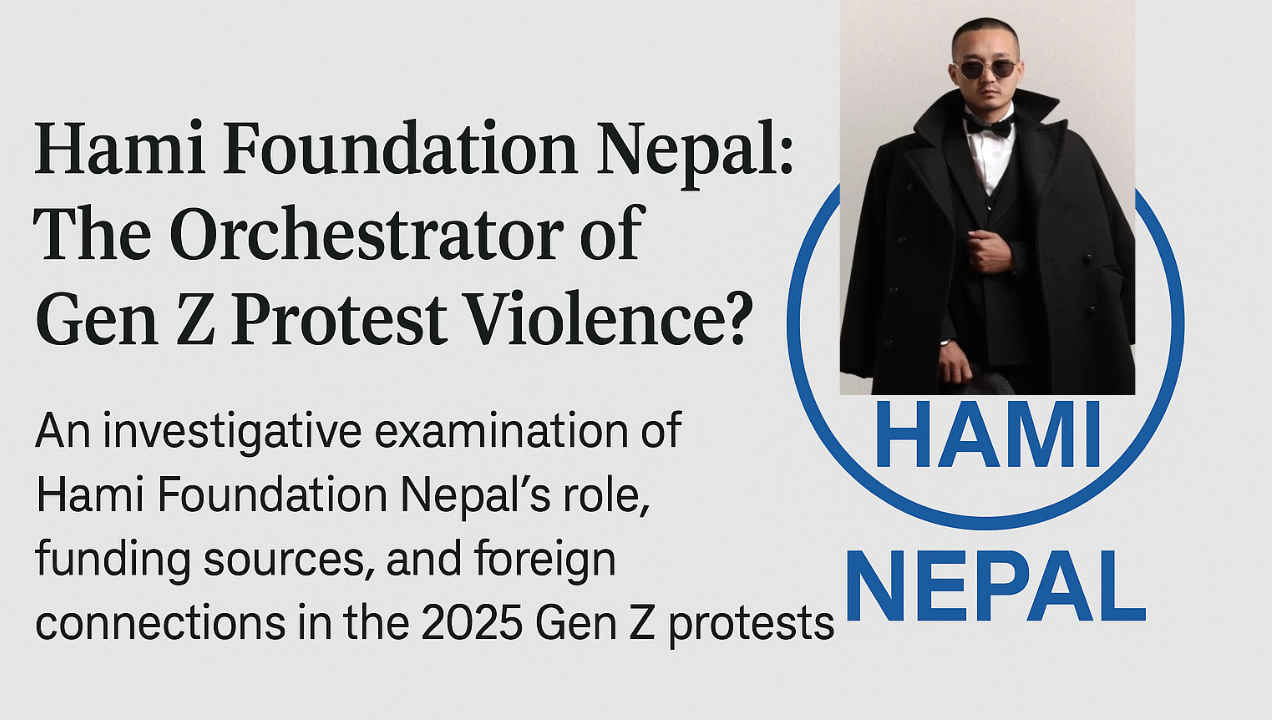Hami Nepal and the 2025 Gen-Z Protests: Philanthropy, Protest, and Power Politics
Introduction

Nepal’s 2025 Gen-Z protests were unprecedented in scale and consequence. What began as demonstrations against a social media ban quickly escalated into violence, resulting in deaths, attacks on public property, and the eventual resignation of Prime Minister K.P. Sharma Oli (pro-Chinese government). At the centre of this upheaval stood the youth-driven organisation Hami Nepal (also called Hami Foundation Nepal).
While Hami Nepal has long presented itself as a grassroots civic movement committed to disaster relief and anti-corruption activism, evidence from public records, corporate disclosures, and media investigations suggests that its role in the protests extended far beyond organising peaceful rallies. Allegations of foreign funding, corporate sponsorship, and political engineering have raised urgent questions about whether the protest was a genuine youth uprising—or a chapter in the larger geopolitical contest between the United States and China in South Asia.
Origins of Hami Nepal
Hami Nepal was founded by Sudan Gurung, an event management professional turned philanthropist, who rose to prominence during Nepal’s 2015 earthquake relief operations. The group initially gained credibility for its grassroots relief work, quickly expanding into community programs and youth engagement. By 2025, the organisation had more than 1,600 active members and styled itself as a civic mobilisation platform under the motto “For the People, By the People.”
Its leaders cultivated a modern, digital-savvy image. Through Instagram, Discord, and TikTok, Hami Nepal tapped into Nepal’s young demographics, creating what many described as a “movement ecosystem” for activism.
The Protests: From Uniforms to Violence
The immediate spark for the Gen-Z protests was the government’s ban on 26 social media platforms, a move deeply unpopular among youth. Hami Nepal called for demonstrations, initially advising students to attend in uniforms to prevent arbitrary arrests.
But the protests quickly escalated. Within days:
- 19+ people were killed, hundreds injured.
- Government buildings and airports were attacked.
- Fires gutted parts of parliament and police stations.
Eyewitness accounts and leaked internal chats (reported by Nepalese media) suggest that while many demonstrators sought peaceful expression, segments of the protest were hijacked by more radical actors. The line between civic activism and organised anarchy blurred.
Funding and Foreign Connections
Corporate Donors
Investigations and press reports show that Hami Nepal received substantial financial backing from international brands:
- Coca-Cola (US): Approximately 20 crore NPR (~USD 1.5 million) in donations, some tied to community drives.
- Viber (Japan): Provided cash and digital resources.
- Goldstar Shoes & Mulberry Hotels (Nepal): Corporate sponsors whose donations were nominally humanitarian but reportedly used for logistics.
Business Figures
- Deepak Bhatta: A controversial arms dealer implicated in corruption scandals; widely cited as a major financial backer of Hami Nepal.
- Sulav Agarwal (Shankar Group): Businessman with deep transnational ties, identified as another financial supporter.
NGO & Media Partnerships
Hami Nepal has partnered with foreign NGOs and international media organisations. Al Jazeera and others reportedly amplified their campaigns. Some analysts note parallels to groups historically linked to Western funding, such as Students for a Free Tibet, which has documented ties to the U.S.-based National Endowment for Democracy (NED).
The Barbara Foundation Connection
Hami Nepal has a close working relationship with the Barbara Foundation, chaired by renowned ophthalmologist Dr. Sanduk Ruit.
- Shared office space and joint events have been documented.
- Barbara Foundation’s international legacy (named after American activist Barbara Adams) draws Western donors into Nepalese philanthropy.
- Critics argue that this relationship provided both credibility and financial leverage for Hami Nepal’s protest activities.
Foreign Powers and the “Toolkit” Hypothesis
Some geopolitical observers argue that Nepal’s protests fit a broader pattern seen in Sri Lanka, Pakistan, and Bangladesh, where youth-led or grievance-based movements quickly evolved into government-toppling unrest.
Publicly available leaked communication (cited in Nepali press) from Hami Nepal organisers shows efforts to:
- Maximise international media coverage of protest violence.
- Incite anti-India and anti-government sentiment online.
- Disseminate “protest guides” covering logistics, escalation, and defensive violence.
While hard proof of direct U.S. or Western government orchestration remains absent in the public domain, the strategic beneficiaries of the regime change—removal of a pro-China government and installation of an interim leadership more palatable to international stakeholders—align with Western interests in curbing Beijing’s growing footprint in Nepal.
Geopolitical Implications
The fallout of Nepal’s Gen-Z protests highlights the fragile position of small South Asian states in the U.S.-China rivalry:
- China: Lost a valuable pro-Beijing government in Kathmandu, undermining its Belt & Road investments and political influence.
- United States & Allies: Strengthened position by cultivating an interim government less beholden to Beijing.
- India: Maintains a cautious stance, wary of foreign-engineered instability but also concerned about losing influence in its neighbourhood.
Transparency & Accountability Issues
Despite its claims of grassroots funding, Hami Nepal’s lack of transparent financial disclosures raises questions:
- Corporate sponsorships far exceed what most NGOs in Nepal report.
- Ambiguities in donor reporting make it difficult to track how humanitarian donations were repurposed for political mobilisation.
- Operational overlap with Barbara Foundation and other entities complicates independent scrutiny.
Conclusion: The Unfinished Story
The story of Hami Nepal is emblematic of how philanthropy, youth activism, and geopolitics intersect in fragile democracies. What began as an organisation for disaster relief evolved into a central player in one of Nepal’s most violent uprisings in decades.
Whether Hami Nepal was the genuine voice of a betrayed generation or the instrument of foreign-backed regime change remains contested. What is certain is that its role cannot be reduced to charity work or simple youth activism. The organisation operated at the nexus of corporate money, international networks, and domestic grievances, with consequences that reshaped Nepal’s political trajectory.
As Nepal transitions under an interim prime minister, the lessons are sobering: transparency, leadership resilience, and geopolitical awareness are the only safeguards against external manipulation of internal unrest.
📌Disclaimer: This article draws on open-source news reporting (Reuters, Al Jazeera, ABC, Times of India), NGO disclosures, and publicly available analyses. Some allegations—particularly regarding foreign intelligence links and protest playbooks—are widely circulated in Nepali and regional media but remain unverified in primary documentation.
Hami Nepal, Hami Foundation Nepal, Nepal Gen-Z protests 2025, Nepal protest violence, KP Sharma Oli resignation, US-China rivalry Nepal, Foreign funding Nepal protests
#HamiNepal #NepalProtests #GenZProtests #Nepal2025 #Geopolitics #USChina #RegimeChange #SouthAsia #ForeignFunding #NepalCrisis #YouthMovements #PoliticalToolkit
Discover more from
Subscribe to get the latest posts sent to your email.











1 COMMENTS